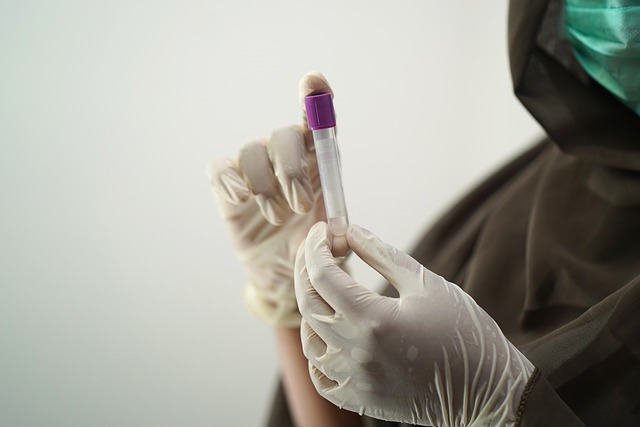The United Kingdom's healthcare system emphasizes early and accurate diagnosis and management of iron deficiency anemia (IDA) due to its widespread occurrence and the symptoms it causes, such as fatigue and pallor. The UK Advanced Thyroid Blood Test is a crucial diagnostic tool that helps in assessing both thyroid function and iron metabolism by measuring ferritin levels, which are key indicators of IDA. Upon detection of anemia, personalized treatment plans are developed, often including iron supplements chosen based on patient tolerance and effectiveness, alongside dietary recommendations to increase iron intake from various sources. Post-diagnosis, patients receive regular follow-up care to monitor their hemoglobin and ferritin levels, ensuring recovery from anemia. The UK healthcare system prioritizes patient education and vigilance for potential side effects or signs of iron overload. For cases where IDA persists despite proper dietary measures, further investigations are conducted to detect any underlying gastrointestinal issues that might impair iron absorption. A multidisciplinary approach involving a range of healthcare professionals is often necessary for effective management of IDA, with the UK Advanced Thyroid Blood Test being pivotal in this process.
Iron deficiency anemia is a prevalent condition, particularly affecting individuals in the UK. This article delves into the pivotal role of advanced thyroid blood tests in diagnosing this nutritional deficiency. We explore the intricacies of these tests, their interpretation, and the subsequent management strategies within the unique context of the UK healthcare system. Understanding the nuances of thyroid function and its relationship with iron metabolism is key to effective treatment and patient well-being. With a focus on the UK’s approach to advanced thyroid blood testing for iron deficiency anemia, we provide a comprehensive guide to post-test management and the array of treatment options available.
- Understanding Iron Deficiency Anemia and the Role of Advanced Thyroid Blood Tests in Diagnosis
- The Process and Interpretation of UK Advanced Thyroid Blood Tests for Iron Deficiency Anemia
- Comprehensive Guide to Post-Test Management and Treatment Options for Iron Deficiency Anemia in the UK Context
Understanding Iron Deficiency Anemia and the Role of Advanced Thyroid Blood Tests in Diagnosis

Iron deficiency anemia is a prevalent condition characterized by insufficient iron levels in the body, which leads to a reduction in hemoglobin and can result in fatigue, paleness, and other symptoms. In the UK, accurate diagnosis and early management of this condition are paramount for maintaining health and well-being. The first line of testing for iron deficiency anemia involves a series of blood tests that measure different components of the blood. These tests include serum ferritin, which indicates iron stores; serum iron, which reflects the amount of iron available to be used by the body; and transferrin saturation, which assesses how well iron is being transported in the blood.
For a comprehensive understanding of thyroid health in relation to iron metabolism, UK advanced thyroid blood tests are invaluable. These tests not only evaluate thyroid hormone levels but also provide insights into the body’s iron handling capabilities. They can detect subclinical thyroid dysfunctions that might otherwise go undetected and could be contributing to anemia or affecting iron metabolism. The integration of these advanced tests allows healthcare providers to tailor treatments more effectively, ensuring that any underlying thyroid conditions are properly addressed alongside iron deficiency anemia. This holistic approach is crucial for improving patient outcomes and for the management of complex endocrine issues in the UK healthcare system.
The Process and Interpretation of UK Advanced Thyroid Blood Tests for Iron Deficiency Anemia

In the United Kingdom, diagnosing iron deficiency anemia is primarily achieved through advanced thyroid blood tests, which offer a comprehensive evaluation of an individual’s iron status. These tests measure various parameters including serum ferritin, transferrin saturation, and hemoglobin levels. The process commences with a healthcare professional taking a blood sample from a vein in the patient’s arm. This sample is then sent to a laboratory equipped to perform specialized thyroid function tests alongside iron profile assessments. In the lab, serum ferritin is quantified to estimate iron stores within the body; lower levels often indicate depletion and a potential iron deficiency. Transferrin saturation, another key indicator, reflects the proportion of transferrin, a protein that binds iron, that is saturated with iron. Hemoglobin levels are also assessed to determine if anemia is present. Interpretation of these results involves considering the patient’s clinical presentation and other relevant factors. For instance, in the context of chronic inflammation or liver disease, ferritin levels may be elevated regardless of iron stores, necessitating a more nuanced understanding of the test results. The UK advanced thyroid blood tests provide a detailed picture that aids in tailoring treatment to the individual’s needs, ensuring accurate diagnosis and effective management of iron deficiency anemia.
Comprehensive Guide to Post-Test Management and Treatment Options for Iron Deficiency Anemia in the UK Context

Iron deficiency anemia is a prevalent condition in the UK, often requiring prompt diagnosis and management to prevent complications. In the UK context, healthcare providers typically employ advanced thyroid blood tests as part of a comprehensive diagnostic approach. These tests not only assess thyroid function but also provide insights into iron metabolism, including ferritin levels, which are pivotal in diagnosing iron deficiency anemia. Upon confirmation of iron deficiency, treatment options are tailored to the individual’s needs, with iron supplementation being a common first step. The choice of iron formulation—whether it be ferrous sulfate, ferrous gluconate, or other preparations—is guided by patient tolerance and response. Additionally, dietary modifications to increase iron intake from sources such as red meat, leafy greens, and fortified cereals may be recommended.
Post-test management is critical for effective treatment and patient follow-up. It involves regular monitoring of hemoglobin and ferritin levels to track the progress of iron stores replenishment and anemia resolution. Healthcare professionals in the UK emphasize the importance of ongoing support and education for patients, ensuring they understand their treatment regimen and recognize signs of iron overload or adverse reactions. For those with persistent iron deficiency despite adequate iron intake, further investigation may be warranted to explore underlying gastrointestinal issues, such as inflammatory bowel disease or Helicobacter pylori infection, which could impair iron absorption. A multidisciplinary approach involving general practitioners, dietitians, and specialists is often necessary to manage iron deficiency anemia effectively, with the UK Advanced Thyroid Blood Test serving as a cornerstone in the diagnostic toolkit.
In conclusion, iron deficiency anemia is a prevalent condition that merits careful and precise diagnosis through advanced thyroid blood tests, particularly in the UK context where such tests are integral to effective treatment. This article has provided a thorough understanding of the condition, outlined the process and interpretation of these specialized tests, and detailed the post-test management strategies along with treatment options available for patients. The importance of accurate testing cannot be overstated, as it lays the foundation for tailored medical interventions and patient care. For those in the UK experiencing symptoms suggestive of iron deficiency anemia, seeking guidance from healthcare professionals and undergoing UK advanced thyroid blood tests is a prudent step towards maintaining health and well-being.
